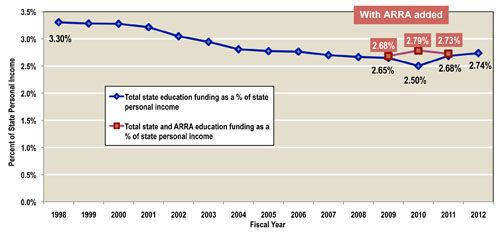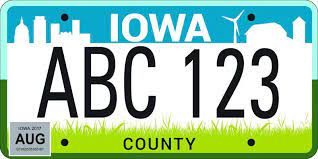Gavin McLeod
https://www.desmoinesregister.com/picture-gallery/life/2015/08/26/photos-the-most-beautiful-views-in-iowa/32427701/
Demographics
- Total public school student population: 485,630
- Public v. private school attendance: 94% of students in public school, 4.7% private
- Graduation rates: 90.2% total, 92.6% white, 77.8% black, 92.9% Asian, 81.6% Hispanic, 75.6% ELL
- Student demographics:
- 6% English Language Learners, 10.2% poverty rate
 90.6% White, 4.1% Black, 2.7% Asian, 0.5% Native American, 6.3% Hispanic/Latino. These percentages add up to more than 100% as some students identify as two or more races.
90.6% White, 4.1% Black, 2.7% Asian, 0.5% Native American, 6.3% Hispanic/Latino. These percentages add up to more than 100% as some students identify as two or more races.
Finances
- Total state public education budget: $3.381B
- Average per pupil expenditure: $11958
- High/low per pupil expenditure within state: High: $18787 Stratford School District, Low: $10743 Central Lee School District
- Average national per pupil expenditure: $12624

The image above displays Iowa’s education spending each year, showing a general decrease in spending over time.
https://www.iowapolicyproject.org/2011Research/110729-education.html
Accountability
- Accountability measures: tests student participation on state assessments, academic achievement, student academic growth, graduation rate, progress in English language proficiency, and a student survey. System adopted in response to the ESSA. Supposed to focus on growth rather than proficiency
- Subject matter assessed by accountability measures: Math, reading and English language proficiency
- Consequences for failing to meet standards—for students, teachers, administrators, and schools: Schools become “targeted” schools, get reviewed closely and get an evidence based intervention, they then decide how to distribute funds more effectively and help the school. Teachers would likely get evaluated individually based on the Iowa Teaching Standards and Criteria
- There are eight standards that teachers are evaluated,:
1. Demonstrates the ability to enhance academic performance and support for implementation of the school district’s student achievement goals.
2. Demonstrates competence in content knowledge appropriate to the teaching position.
3. Demonstrates competence in planning and preparing for instruction.
4. Uses strategies to deliver instruction that meets the multiple learning needs of students.
5. Uses a variety of methods to monitor student learning.
6. Demonstrates competence in classroom management.
7. Engages in professional growth.
8. Fulfills professional responsibilities established by the school district.
- Testing or proficiency graduation requirements: Must satisfy the requirements of the Iowa Core that requires the standard proficiency in math, reading, and the English language, but also requires financial and technological literacy as well
- Adoption of Common Core: Iowa core, standard requirements, but not a standard curriculum. Individual districts and schools choose how to fulfill the requirements individually
- Adoption of Next Generation Science Standards: 15th state to adopt the NGSS in 2015
Charters and Vouchers
- Number of charter schools and percentage of students served: 2 charter schools, 0.6% of the student population
- Voucher dollar amounts and percentage of students served: serves 2% of students, $5500 per voucher
- Permissible voucher use (i.e., religious schools): Any private school of the families choice
Teachers
- Average teacher salary: $58421
- Presence of teachers’ unions/collective bargaining: The Iowa State Education Association (ISEA)
- Merit pay for teachers: Pay for performance program, anywhere from $750-2000 extra pay for those who qualify
- Teacher evaluation methods and measures: Iowa Teaching Standards and Criteria, 8 standards being evaluated
Data Analysis
To nobody’s surprise, the school districts that receive the lowest funding per student in turn have some of the lowest graduation rates within the sate. Unfortunately, as we have seen across the country, this disproportionately impacts minority students. A good example of this would be the Ottumwa school district. This district is one of the poorest in the state and also has one of the largest non white communities. Ottumwa only has a 58% white community, more than 30% less than the overall state demographics. The combination of the large minority population, lower funding, and lower graduation rates is a combination seen all too often in the world of education.
This is not a statistic specific to Ottumwa school district either. Looking at the overall graduation rates across the demographics, we see that every minority group (apart from Asians, who have the benefit of historically being a model minority group and most of the time suffer less oppression than the other demographic minorities) we see an unfortunate trend. All groups have at least a 10% lower graduation than the white English speaking community. This means that the communities with higher minority percentages have lower graduation rates overall compared to their whiter counterparts (as demonstrated by Ottumwa). Unfortunately, these issues become even more clear nationwide in states and cities that have drastically higher minority communities than we see in Iowa. Iowa is the 7th whitest state in the US with a 90.6% white community, so compared to places like New York or the District of Columbia, we see much less diversity and therefore less opportunities to see how rampant educational oppression still is.
Event Analysis
In recent history we are seeing a trend. We are seeing historically oppressed and unaccepted groups losing the rights and legal ground they fought so hard to achieve. Things like the “Don’t Say Gay” bill in Florida (as well as many other similar policies being adopted or pushed for throughout the south), as well ax the more recent news of the possible overturning of the Roe v. Wade decision make it easy to have a pessimistic outlook of the future of our countries children and their freedoms going forward. Policies like the “Don’t Say Gay” bill in Florida specifically impact the freedoms and safety of transgender and non-heterosexually oriented individuals in schools. Thankfully, this is not the case across the country. In light of these recent events, a lot of positive work is being done to combat these oppressive steps backward.
Specifically, one school district in Iowa has been receiving some attention within the last week (the week of May 9, 2022) for some good news regarding this topic. The school district of Linn-Marr has passed a policy allowing students as soon as 7th grade to openly identify as transgender within schools, as well as keep this private from their parents if they wish. This policy is following a recent trend in Iowa schools to work to specifically protect their transgender students, given all the negative news that has taken the headlines in national news about educational policy. Linn-Marr isn’t the first or the last school district in Iowa to adopt pro trans rights policies, but it is a shining example of what has been accomplished and what is to come in the following months and years.
Citations:
– “About Iowa Core.” About Iowa Core | Iowa Core, https://iowacore.gov/about-iowa-core.
– Hernandez, Samantha. “Iowa’s 2021 High School Graduation Rate Is down. Here’s How to Find Your District’s Rates.” Des Moines Register, Des Moines Register, 7 Mar. 2022, https://www.desmoinesregister.com/story/news/education/2022/03/07/iowa-high-school-graduation-rates-down-after-covid-pandemic-coronavirus-department-of-education/9411292002/.
– Iowa Department of Education, 11 May 2022, https://educateiowa.gov/.
– Iowa Department of Education, 11 May 2022, https://educateiowa.gov/.
– “Iowa School Performance.” Iaschoolperformance.gov, https://www.iaschoolperformance.gov/.
– “Lead State: Iowa.” Lead State: Iowa | Next Generation Science Standards, https://www.nextgenscience.org/lead-state-iowa.
– McCann, Adam. “Most & Least Equitable School Districts in Iowa.” WalletHub, 3 Aug. 2021, https://wallethub.com/edu/e/most-least-equitable-school-districts-in-iowa/77078.
– Salary.com, Site built by: “Public School Teacher Salary in Iowa.” Salary.com, https://www.salary.com/research/salary/benchmark/public-school-teacher-salary/ia.
– Sitter, Phillip. “Iowa Is One Step Closer to Opening More Charter Schools. Here’s What That Means for Families.” Des Moines Register, Des Moines Register, 18 Nov. 2021, https://www.desmoinesregister.com/story/news/education/2021/11/18/department-education-iowa-charter-schools-rules-application-process/6402140001/.
– Webster, Author: Jenna. “Iowa Department of Education Reports Increase of Teachers during Pandemic.” Wqad.com, 4 Dec. 2021, https://www.wqad.com/article/news/education/iowa-department-of-education-releases-school-report/526-ee662dd2-712d-4cbd-846a-6a99fc8119fe#:~:text=48.8%25%20of%20students%20from%20Iowa’s,was%20%2410%2C794%2C%20up%20from%20%2410%2C738.
– White, Lauren. “Fact Check: Iowa’s Student First Voucher Bill Would Benefit 2 Percent of Iowa School Children.” The Daily Iowan, https://dailyiowan.com/2022/04/07/fact-check-iowas-student-first-voucher-bill-would-benefit-2-percent-of-iowa-school-children/.

